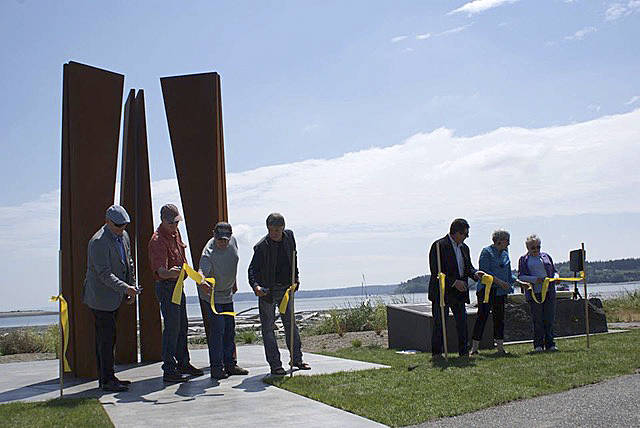A striking sculpture now marks the beach site where Oak Harbor’s founding pioneers first intended to lay claim to the new territory.
The recently dedicated Land Claims Founders Sculpture by Richard Nash is a work of art as well as a historical marker.
It’s located in Windjammer Park directly behind the baseball fields and playground adjacent to the end of City Beach Street.
The contemporary 12-foot high sculpture is meant to be seen by land, sea and air.
It symbolizes the three settlers — Ulrich Freund, Clement Sumner and Zakarias Taftezon — and serves as a tribute to their endeavour as well as all pioneering spirits, said Sue Karahalios, who led the push for official recognition of the founders.
“This sculpture tribute highlights the path of Oak Harbor’s beginnings,” she said. “It’s exciting that we’re going to have this modern reminder of our history.”
She credited the community for making the long-time dream become reality.
“I am so grateful to the number of people who believed in this project,” Karahalios said. “The beauty of Richard’s sculpture in symbolizing our beginning, it just feels wonderful to see it in place.”
Private contributions paid for more than 90 percent of the project and funding from the Oak Harbor Arts Commission paid for the rest. Many local businesses donated materials and volunteer labor.
Karahalis said the artwork is particularly stunning at night when small lights reflect off the base.
Nash said if he were to give his piece a nickname, it would be “The Conversation.”
“The base of the triangular runs parallel with the main pathway at the park,” Nash wrote in an artist statement.”Because the 12-foot structures angle in, it provides a more intimate entry to the sculpture’s interior. In a way, it invites the viewer to walk in and join the discussion, while the perimeter walkway allows another view of the architectural-like composition.”
At the time of the founders’ arrival, the beach — now known as Lions Club Park — was the site of a Skwdab tribe (a subgroup of the Skagit tribe) encampment.
The settlers were guided by members of the Tulalip tribe, who were afraid to land at that beach because they were at war with the Skwdab, according to historical research provided by the Tribute Team that spearheaded the project.
The men, instead, landed on the eastern side of Maylor’s Point, where it is said Taftezon climbed to the top of the rise separating east and west Crescent Harbor and proclaimed “Eureka! We have found our earthly paradise.”
Each of the men filed an official Donation Land Claim for 320 acres on Jan. 4, 1851.
The dedication of the monument transferred ownership to the city of Oak Harbor from the Tribute Team.
One way or another, the Founders Sculpture will have an impact on first-time viewers, Nash predicted.
“Whether it is positive or negative, my hope is that (people) visit it many times over the years,” the artist said.
“Every lighting situation will provide new and interesting discoveries. For those who are ambivalent, give it some time.
“For those of you who are disappointed, that it’s not representational, I paraphrase a City of Oak Harbor Council member, ‘The George Washington Monument doesn’t exactly look like Washington’.”


